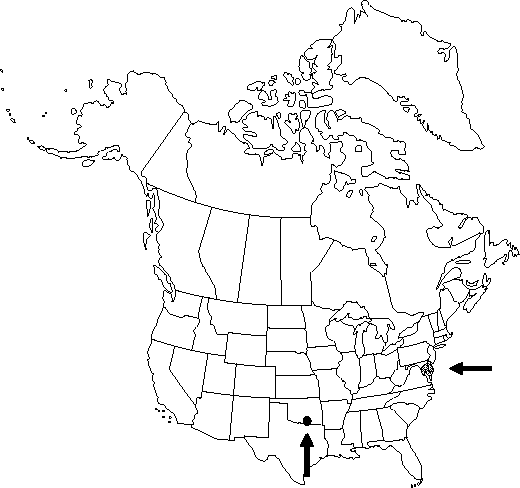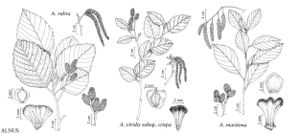Alnus maritima
N. Amer. Sylv. 1: 50. 1842.
Shrubs or trees, to 10 m; crowns narrow. Bark light gray, smooth; lenticels small, inconspicuous. Winter buds stipitate, ovoid to ellipsoid, 2.5–5 mm, apex rounded; stalks 1–3 mm; scales 2–3, subequal, often poorly developed, heavily resin-coated. Leaf-blade narrowly elliptic, oblong, or narrowly obovate, 4.5–9 × 2–5 cm, leathery, base acute to cuneate, margins flat, teeth low, single, relatively distant, apex acute, obtuse, or rounded; surfaces abaxially mostly glabrous, resin-coated when young. Inflorescences: catkins formed during same season as flowering; staminate catkins in 1 terminal cluster of 2–4, 2–6 cm; pistillate catkins solitary in leaf-axils proximal to staminate catkins. Flowering in late summer or early fall. Infructescences ovoid, 1.2–2.8 × 1.2–2.2 cm; peduncles 5–10 mm. Samaras elliptic, wings reduced to narrow, leathery ridges. 2n = 28.
Phenology: Flowering late summer–early fall.
Habitat: Along edges of ponds and small streams, often in standing water
Elevation: 0–100 m
Distribution

Del., Md., Okla.
Discussion
Alnus maritima consists of widely disjunct populations in Delaware, Maryland, and southern Oklahoma. The populations probably represent remnants of Pleistocene and post-Pleistocene distributions and migrations. It is our only member of the predominantly Asian fall-blooming Alnus subg. Clethropsis.
Selected References
None.
